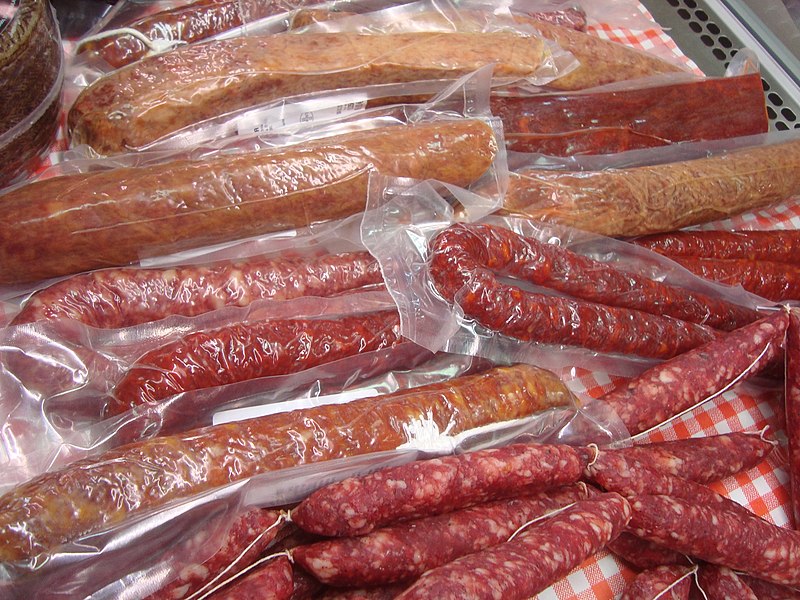Downloads:

General information
Keywords
Conservation, vacuum, sealing, modified atmosphere
Level

General information
VACUUM PACKAGING AND CONSERVATION
In the kitchen, the technique of vacuum conservation is applied when we pack food in an airtight container. One of the main objectives of vacuum packaging and conservation is to maintain the nutritional qualities of the food and prolong its durability.
The simplest process is to remove air from the free space that exists inside the package; it is also possible to complement the preservation of food in a modified atmosphere by inserting inert gas.
The vacuum technique allows to increase the product's useful life. To be effective, the package must be properly sealed and stored at the appropriate temperature.
All food groups can be vacuum packed, including solid or liquid foods, in their original state or previously prepared.
There are foods that breathe (such as fruits and vegetables) and foods that do not breathe (such as meat and meat products, fish, pasta, among others). Fruits and vegetables breathe even after harvest, and, whether fresh or processed, consume oxygen and produce carbon dioxide.
Therefore, there are some precautions to be observed:
- If the food has a green component, it must be previously scalded and drained to avoid the release of gas (e.g. spinach); if not, it can be packed raw (e.g. carrot).
- Certain fruits should only be placed in a vacuum if their consistency allows (e.g. apple).
- The loss or gain of water can change the consistency, texture and appearance of the food, such as its characteristic crunch or color.
- Dry products sensitive to oxidation must be protected against light, avoiding rancidification (e.g. walnut).
Kitchen professionals apply vacuum conservation especially to the following foods: fruits and vegetables, garlic, cheese, dry foods, fresh meats and fish, seafood, cooked dishes, jams and sweets.
Vacuum packaging can also be used for preparing specific dishes, such as sous vide (see Module 4, Advanced Level, Unit 1).
Description
Labels
Benefits
The purpose of vacuum packaging is to avoid the use of chemical substances to preserve the food, whether fresh or processed, extending its life, keeping its flavor, aroma, color and nutritional qualities unchanged, delaying the ripening and discoloration of the food, and preventing the development of unpleasant odors and flavors, without the potentially harmful effects of preservatives on our body.
The conservation can be done in the refrigerator, in the freezer (in a professional environment, the freezer should be properly cooled), or simply in the pantry.
This technique optimizes the level of hygiene in the kitchen and streamlines the process of preparing and cooking food.
It also makes it possible to store the food of each season for later consumption, reducing the environmental footprint and fighting food waste.
In terms of management, vacuum packaging and conservation is an ally of kitchen professionals, saving space and optimizing storage, and facilitating the creation of menus.
Representative Products
Vegetables (cabbage, white cabbage, cauliflower, pumpkin, carrot, onion), fruit (apple, pear, pineapple), legumes (beans, peas, broad beans), tubers (potatoes), cereals (rice, corn, wheat), fish (sea bream, mullets, sea bass, trout), meat (goatling, poultry, pork), seafood (shellfish, bivalves, crustaceans), jams and marmalade, pastry creams.
Risks
Kitchen professionals should have great care when handling and preparing food products to package them in a vacuum.
To avoid incidents, certain practices must be respected, such as:
- use appropriate bags or packaging containers to prevent the exchange of gases and odors or their rupture due to the pressure of the inserted gas. In the case of sous vide cooking, the packaging must be made with retractable bags, conceived for that purpose.
- check the condition of the containers with food regularly, as they can implode or break due to depression, constituting a risk of entry of atmospheric air, which will change the entire flavor and texture of the packaged ingredients;
- check that the vacuum machine is working properly.
It is also possible to pack food in vacuum at home applying several techniques:
- use a domestic vacuum packaging machine;
- use containers with special lids and the aid of a vacuum pump;
- remove excess air inside the package through a tube, or leave only a small opening, press the food, and quickly close the package.
The techniques described above do not remove all of the air inside the package, with implications in the durability and conservation of the product.
The durability of vacuum packaging is related to the characteristics of the food product. According to available information, vacuum packaging has a durability of 15 to 17 days; if it is vacuum packaging with inert gas, it has a durability of 30 days. The durability of the food product could be longer if vacuum cooking reaches pasteurisation temperature.
Good practices in professional environments recommend products packaged in a vacuum to be regularly sent for laboratory analysis.
Further references
https://www.sousvidetools.com/eu/about-vacuum-packing
https://www.nationalproductreview.com/au/articles/10-benefits-vacuum-sealing-food/
https://www.vacmasterfresh.com/fresh-bites-blog/top-15-advantages-to-vacuum-sealing-your-food/
 Play Audio
Play Audio

